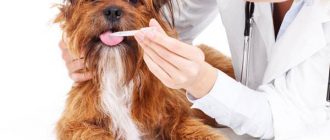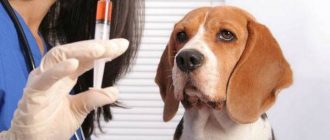The period of motherhood for the dog and its owners is beautiful, but with this is a dangerous time, as weakened by pregnancy and childbirth the body is in wait for various ailments. Mastitis in a dog is one of the most common diseases in the postpartum period. How is he manifests itself and how to help the female in this difficult time for her?
Content
- 1. Varieties of mastitis in dogs
- 2. Causes of mastitis in dogs
- 3. Clinical manifestations of the disease
- 4. Treatment of mastitis in a dog
- 4.1. A real example of the treatment of mastitis:
- 5. How to prevent the disease
Varieties of mastitis in dogs
Contents
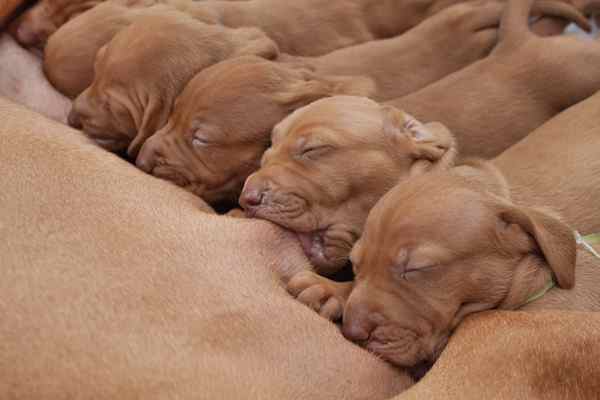
First of all, it is worth figuring out what kind of disease it is. Mastitis, in most cases, appears after childbirth or with a diagnosis false pregnancy, that is, its development is directly related to intensive secretion of milk in the mammary glands. Among the germs, most often provoke mastitis streptococcal and staphylococcal sticks.
The following types of disease are distinguished:
- Catarrhal mastitis. This kind of disease is dangerous. the fact that, having no specific experience, it will be very difficult. Symptoms are practically absent, except for the presence of secretory secretions of mucus. Without timely treatment of catarrhal mastitis develop more serious forms of the disease – serous mastitis or catarrhal-purulent.
- Serous mastitis. In secreted by dairy with glands of milk, inflammatory exudate appears. This a variety of the disease is also impossible to detect without clinical diagnosing.
- Fibrous type. In this case, simultaneously with fibrin filaments appearing in milk from the glands, having the appearance of white, tight cords.
- Purulent type of mastitis. In the milk of a nursing dog foreign particles of pus appear – may look like stretching threads or individual pieces of a whitish or yellowish hue. Milk in in most cases, changes in color and smell. With this form mastitis breastfeeding should be stopped immediately.
- Phlegmonous mastitis. With this disease pus accumulates in the subcutaneous tissue layer and spreads throughout the inner layers of the skin. Initially, it does not get into milk, but after bacteria spread to the lobes, purulent chunks will be seen in milk.
- Abscessive mastitis. This form is manifested in the form of an abscess on the affected part of the mammary glands. Abscessing mastitis is very rarely diagnosed.
- Mastitis of a gangrenous nature. Considered the most severe form of the disease in which breast tissue die and decompose.
Causes of mastitis in dogs
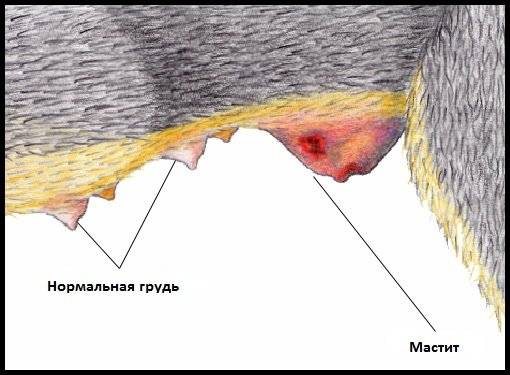
There are many reasons why a dog can mastitis develop. These include the following:
- Injury of the mammary glands by sharp claws of puppies during feeding can lead to harmful wounds getting into the wounds bacteria that provoke inflammation.
- Stagnant processes in the mammary glands (it is called stagnant mastitis) caused by the accumulation of milk that remains in the udder, if the dog has a dead offspring, they’ve taken away breast, or with strong lactation.
- With emphysematous fetuses (decomposed in utero), the fetus, which lingered in the birth canal, infection of the female during carrying offspring with endometritis, as well as gastrointestinal diseases, in the body gets an infection that causes intoxication and inflammation, including in the mammary glands.
- False pregnancy can also cause breast mastitis. glands.
- Clogging of the flowing sphincter of the nipple leads to stagnant, and then inflammatory processes.
In principle, mastitis in a bitch may appear due to a wide variety of impacts – excessively high or low temperatures, ingress of chemicals into the area of the mammary glands, violations hormonal background, and even a stressful situation can provoke similar inflammation.
Well-groomed bitches that got pregnant in a dirty place are most often suffer from mastitis. In addition, if the mother of the bitch had mastitis, then chances are that he will appear in her.
Clinical manifestations of the disease
As mentioned above, not all types of mastitis can be diagnose on their own, due to the absence of a disease clear symptoms, but, in most cases, there are still certain characteristic features:
- the dog becomes lethargic, inactive, eats little or not at all refuses food;
- with the naked eye it can be seen that the mammary glands swell, with feeling hot, and the dog feels pain from touch;
- the skin on the glands redden;
- if you push on the nipple, then milk with admixture of purulent exudate (greenish-brown, grayish cereal); with a purulent form of mastitis, a thick gray outflow from the nipple mass, possibly with a blood admixture.
If medical attention is not provided on time, then the dogs may A mastitis symptom appears called an abscess. In total places accumulations of purulent masses are opened, a fistula is formed, from which oozing gray pus with particles of dead tissue. Similar condition can cause gangrenous infection of the udder.
Dog mastitis treatment
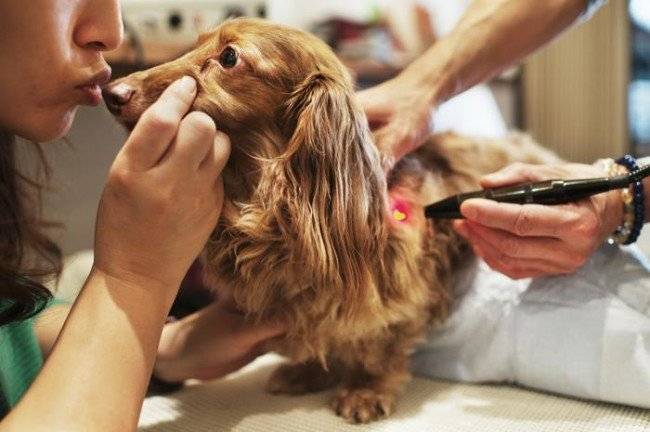
In the photo, treatment of the dog with laser therapy
After diagnosis, the question arises: “How to treat mastitis in a dog? “. First of all, a sick dog needs complete rest. If she is feeding offspring, then she needs to be freed from this duties and transfer puppies to artificial nutrition, or transfer to another lactating bitch.
Conservative is used to treat the initial stages of mastitis. therapy:
- Laser Therapy Conducted using special laser appliances. For this treatment, 3-5 sessions are sufficient one and a half to two minutes.
- Antibiotic therapy. Drugs are prescribed based on the reason the development of the disease. Best if the dog passes diagnostic examination to identify the pathogen from secretory milk secretions.
- Novocainic blockade. This method is used to treat the initial stage of purulent or catarrhal type of mastitis. Blockade carried out by injecting a solution of novocaine around the affected area. If necessary, manipulation is recommended. repeat after three days. With outpatient therapy, blockade can spend every three days using the antibiotic bicillin-3.
In the recovery phase, heat can be applied to the affected mammary glands – heating pads, compresses, paraffin wax applications, tube irradiation. The use of ozokerite gives an excellent result. (mountain wax), as it warms up even the deepest layers of tissues.
If mastitis is accompanied by an abscess, then thermal procedures do not recommended, as they can provoke an autopsy of purulent accumulation and ingestion of pus on healthy tissue.
In modern medicine, it is used to treat mastitis in dogs. Mastometrine, which eliminates inflammation and restores the functionality of the endometrium. Often use it together with traumatine, injecting in the same syringe into the muscle or subcutaneously. The course of treatment lasts from three to five days.
If conservative treatment does not give positive dynamics in for several days, then in the presence of multiple abscesses with purulent formations are prescribed surgical intervention.
Abscesses are revealed, the cavities cleared of pus are filled up antimicrobial powder agents, for example, streptocide or Tricillin. Then, until complete healing of the damaged areas lubricated with ointments with antimicrobial and regenerative action.
A real example of the treatment of mastitis:
How to prevent the disease
Each owner must take full care of his pet:
- provide hygienic conditions;
- provide a complete diet;
- look after the dog’s coat and teeth;
- ensure that the pet is not injured;
- avoid overcooling the dog.
The dog requires especially careful care during gestation offspring and the postpartum period. At this time, the animal may various complications develop, and the owner must ensure timely treatment.
If the pet is kept in a booth or street aviary, then it is necessary to insulate the booth and monitor the cleanliness of the litter, changing them as it gets dirty. Litter should not be made of material that cannot be sanitized and cleaned (straw, hay, wood shavings). In winter, it is advisable to close the doorway with a curtain, protecting against wind.
If we are talking about a dog kept in an apartment, then before she needs to equip a suitable place with childbirth. It should not located in the bathroom or kitchen, also not a suitable place is the threshold of the apartment.
A puppy lined with a cloth is best for whelping. After birth, the contaminated bedding must be replaced with a clean one. That the animal easily left the box and returned back, not having injured the nipples on the edge, one side can be made lower than the others and upholstered its dense material.
After giving birth, the dog’s body should be wiped with a napkin or soft a cloth moistened with a weak solution of potassium permanganate, especially carefully treating contaminated places.
We should not forget about caring for the appearance of the dog, even after childbirth, it must be cleaned with a brush or other device, comb the hair. Caring for the baby will avoid the occurrence of serious diseases.




